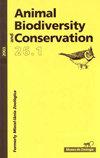马鹿角的超声速度:密度的非侵入性相关和相对质量的潜在指标
IF 1
4区 环境科学与生态学
Q3 BIODIVERSITY CONSERVATION
引用次数: 0
摘要
鹿角可以作为个体在生态和生产环境中表现的指标。它们的质量通常只能通过它们的生物特征来衡量,例如大小、不对称性或重量。机械特性通常无法在不破坏鹿角的情况下进行测量,从而失去奖杯的商业价值。在这里,我们研究了伊比利亚马鹿(Cervus elaphus hispanicus)铸造鹿角不同截面的超声波速度、密度和抗拉强度。我们发现速度值取决于鹿角的截面和传播方向。对于鹿角切片,中梁的速度最低,眉骨的速度最高。密度和间接抗拉强度的结果相似,可能与鹿角切片的功能差异有关。密度解释了超声波速度的大部分可变性。鹿角脱落后经过的时间对密度的影响大于超声波速度。间接拉伸强度与超声速度呈非线性减速关系。我们讨论了超声速度作为一种非侵入性工具在测量鹿角和鹿角切片的密度和物理特性方面的应用,以及它们作为质量指标的潜在用途。本文章由计算机程序翻译,如有差异,请以英文原文为准。
Ultrasound speed in red deer antlers: a non–invasive correlate of density and a potential index of relative qualit
Deer antlers can be used as an index of individual performance both in ecological and productive contexts. Their quality is often measured only by their biometrical features, such as size, asymmetry or weight. Mechanic characteristics cannot normally be measured without destroying the antler and hence losing the commercial value of the trophies. Here, we studied ultrasonic velocities, density, and tensile strength across various sections of cast antlers of Iberian red deer (Cervus elaphus hispanicus). We found that the speed value depended on the section of the antler and the propagation direction. For antler sections, velocities were lowest for mid–beam and highest for brow tine. Results were similar for density and indirect tensile strength, probably related to differences in functionality among antler sections. Density explained most of the variability of ultrasound–speed. The time elapsed from antler shed affected density more than ultrasound speed. The indirect tensile strength showed a non–linear, decelerating relationship with ultrasound speed. We discuss the applications of ultrasound speed as a non–invasive tool to measure density and physical properties of antlers and antler sections, and their potential use as an index of quality.
求助全文
通过发布文献求助,成功后即可免费获取论文全文。
去求助
来源期刊

Animal Biodiversity and Conservation
农林科学-动物学
CiteScore
2.00
自引率
0.00%
发文量
21
审稿时长
>12 weeks
期刊介绍:
Animal Biodiversity and Conservation (antes Miscel·lània Zoològica) es una revista interdisciplinar, publicada desde 1958 por el Museu de Ciències Naturals de Barcelona. Incluye artículos de investigación empírica y teórica en todas las áreas de la zoología (sistemática, taxonomía, morfología, biogeografía, ecología, etología, fisiología y genética) procedentes de todas las regiones del mundo. La revista presta especial interés a los estudios que planteen un problema nuevo o introduzcan un tema nuevo, con hipòtesis y prediccions claras, y a los trabajos que de una manera u otra tengan relevancia en la biología de la conservación. No se publicaran artículos puramente descriptivos, o artículos faunísticos o corológicos en los que se describa la distribución en el espacio o en el tiempo de los organismes zoológicos.
 求助内容:
求助内容: 应助结果提醒方式:
应助结果提醒方式:


